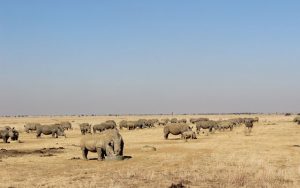A Regulated Trade in Rhino Horn
By Mike Eustace
There were said to have been 100.000 rhino in Africa in 1960. That number should have grown to 1.6 million today, at a growth rate of 6% p.a., but poaching has reduced it to less than 25.000, or 1.6% of what it should have been.
About 20.000 of Africa’s 25.000 rhino are in South Africa.
CITES (The Convention for International Trade in Endangered Species) banned international trade in horn 35 years ago but all that the ban achieved was to push the trade underground where it has made money for criminals and not for conservation.
How would a regulated trade work?
South Africa could form one agency to control all the legal trade. The Agency would enter into partnerships with a few Chinese State Pharmaceutical companies and sell marked horn to them from legitimate suppliers such as KZN Wildlife and Sanparks.
The sale would not be an auction but a “sight”. The way a sight works is for a buyer to be invited into a sales-room and be shown a parcel of several horns. He is told the weight and price for the parcel. He has to buy the whole parcel at the offered price or nothing. He knows that the wholesale price, which he is being offered, is half the retail price, so he will probably buy.
Some people caution that if there is a legal trade “there may not be enough rhino to meet the demand for rhino horn”. That argument is spurious because price will always bring demand into balance with supply. The annual supply to the market now is about 400 horns. Demand is brought into balance with supply at a wholesale price of $20.000, per Kg. We can collect 400 horns p.a. from natural deaths alone, i.e. 2% of our population. We also have stocks that would satisfy the current market volumes for 10 years. South Africa could easily supply 800 horns p.a. without having to kill one rhino.
Illegal goods typically sell at a discount of 30% and if the Chinese state is a partner in the legal trade then one can expect them to be more robust at closing down the illegal trade. The prices to the illegal trade will become less and their business risks much higher.
The only way to get horn now is to poach and kill the animal. If there was a legal trade, South Africa would earn R200 million per annum for conservation and in 12 years time that would grow to R400 million, and to R800 million in 24 years. These amounts are at current prices, not inflated prices. We would also have 80.000 rhino in 24 years time, and not fewer than 20.000, which is the current outlook.
The current ban on trade makes little sense. It seems to me that a regulated trade would be a better plan.
(Source: Mr. Mike Eustace at eustacem@global.co.za)






